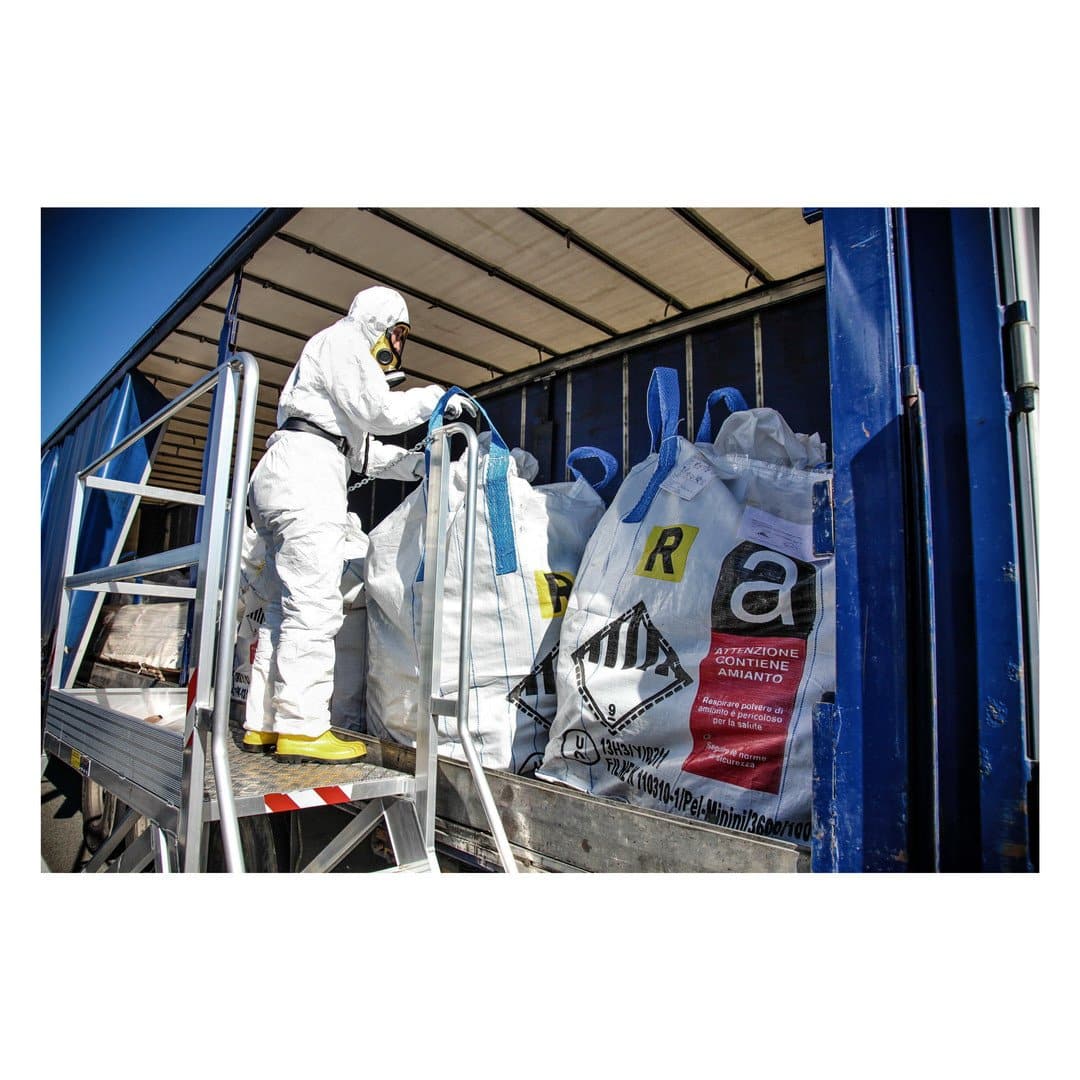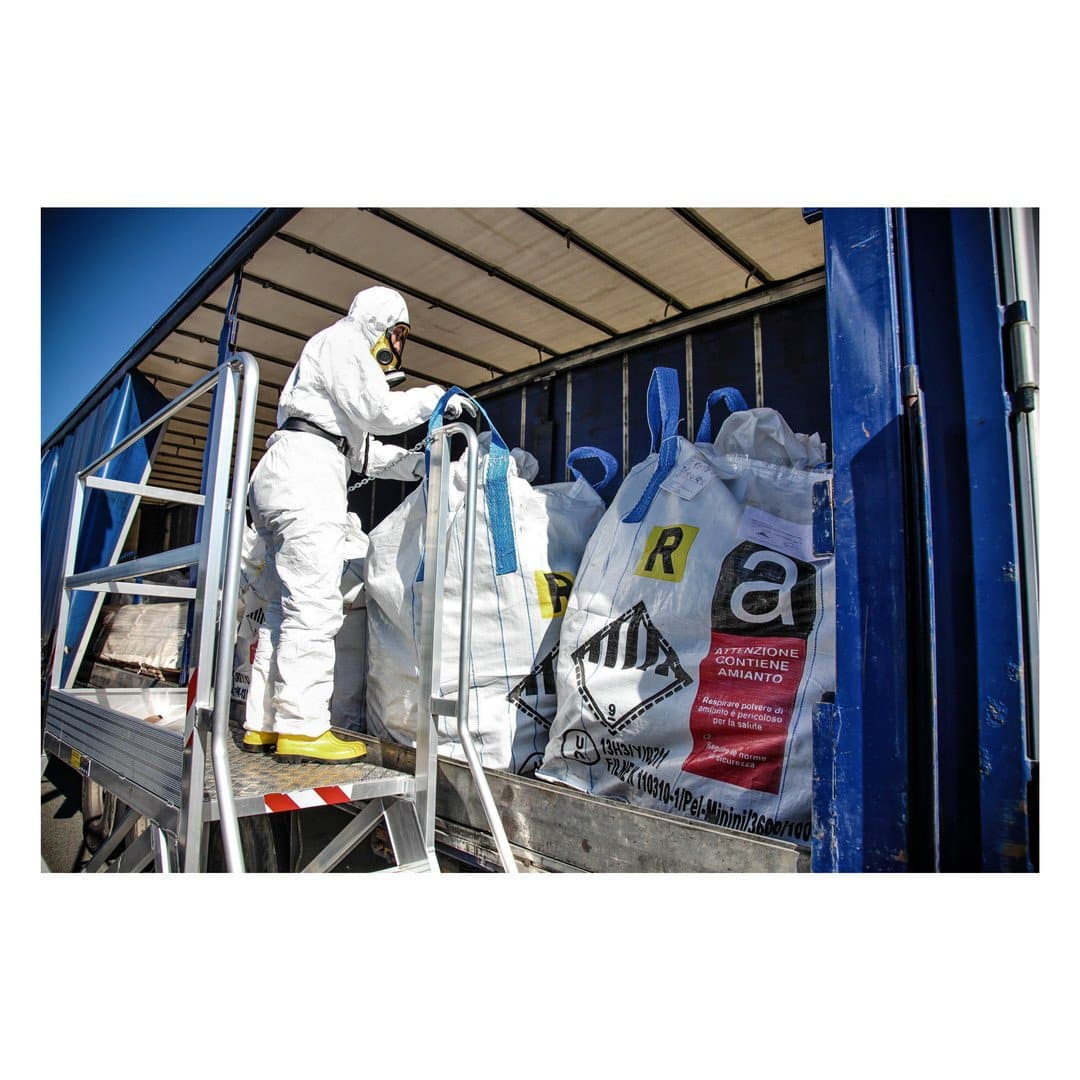Asbestos Awareness Training Course Online

Asbestos Awareness Training Course Online
This course focuses on highlighting the importance of managing Asbestos in the workplace. Asbestos is a hazardous material that poses a risk to health by inhalation if the asbestos fibres become airborne and people are exposed to these airborne fibres. Exposure to asbestos fibres is known to cause mesothelioma, asbestosis and lung cancer. It is important for employees who may work in buildings that contain asbestos to know where it is likely to be found and how to avoid exposure.
Successful completion of this training course, participants will be enabled to:
- Identify relevant OHS/WHS legislation that applies to asbestos
- Identify asbestos
- Identify likely asbestos containing material
- Know the health effects of exposure to asbestos
- Establish and maintain safety procedures
- Identifying when a license Is required when removing asbestos
- Identifying the requirements for selection and use of relevant PPE
- Acquire knowledge and understanding of asbestos removal
- Safety requirements of working with asbestos
Asbestos-containing materials were used extensively in Australian buildings and structures, plant and equipment and in ships, trains and motor vehicles during the 1950s, 1960s and 1970s, and some uses, including some friction materials and gaskets, were only discontinued on 31 December 2003.
The well-known adverse health consequences of exposure to airborne asbestos fibres can be prevented if precautions are taken and appropriate procedures are followed. Strong management and control of all asbestos-containing materials (ACM) in the workplace is essential. The risks posed by asbestos vary depending on the nature and condition of the materials and the potential for exposure.
Do you agree that it is a good idea to reduce the risks associated with asbestos in the workplace? Good, let’s start by looking at when and where asbestos has been used in Australia.
What are the historical uses of asbestos?
Asbestos is the fibrous form of mineral silicates belonging to the serpentine and amphibole groups of rock-forming minerals.
The most common form of asbestos used in Australia is crocidolite (blue asbestos), and chrysotile (white asbestos). Crocidolite and chrysotile account for over 95% of asbestos based materials used in Australia. Other mineral forms of asbestos were not widely used.
As a naturally occurring mineral fibre, asbestos is mined and then broken down from mineral clumps into groups of loose fibres.
Asbestos has excellent fire resistance, insulation properties, fibre strength, durability and flexibility. As a result, it was used in more than 3,000 products, including heat-resistant textiles (cloth, padding and board), asbestos cement products (sheets and pipes), special filters for industrial chemicals, thermal insulation products (pipe and boiler insulation), friction materials (clutch plates, brake linings), gaskets, floor tiles, roofing materials, packing materials, paints and protective paper.
A major historical use was as sprayed thermal insulation on steel beams for fire protection. This sprayed or ‘limpet’ asbestos poses the greatest health risk, because of its highly friable nature.
Asbestos-containing materials (ACM) may still be encountered throughout public and private buildings and structures, especially those built between the 1950s and the late 1970s to early 1980s. Some uses of ACM continued until 2003, notably in friction materials (brakes) and gaskets.
What types of asbestos were produced and used in Australia?
Asbestos is the name applied to six naturally occurring minerals that are mined from the earth. The different types of asbestos are:
Commonly used in Australia
Serpentine
- Chrysotile
Amphibole
- Amosite
- Crocidolite
Not commonly used in Australia
Actinolite
Anthophyllite
Tremolite
In Australia, mostly chrysotile asbestos was mined until 1939. With the commencement of mining at Wittenoom in Western Australia in 1937, crocidolite dominated production until the final closure of this mine in 1966. New South Wales, the first State to mine asbestos, produced the largest tonnages of chrysotile (until 1983), as well as smaller quantities of amphibole (until 1949).
Australian asbestos production and exports declined after the closure of the Wittenoom mine, and imports of chrysotile also started to decline. Consumption peaked in about 1975, at 70,000 tonnes/year.
Australia also imported many manufactured asbestos products, including asbestos cement articles, asbestos yarn, cord and fabric, asbestos joint and millboard, asbestos friction materials and gaskets. The main sources of these products were the United Kingdom, the USA, the Federal Republic of Germany and Japan.
In Australia, the asbestos cement manufacturing industry was responsible for over 60% of all production and 90% of all consumption of asbestos fibre. From about 1940 to the late 1960s all three types of asbestos were used in this industry. The use of crocidolite was gradually phased out from 1967, but amosite was used until the mid-1980s. Much of this industry output remains in service today in the form of ‘fibro’ houses and water and sewerage piping.
Between 1945 and 1954, 70,000 asbestos cement houses were built in New South Wales alone (52% of all the houses built in that State). In Australia as a whole, until the 1960s, 25% of all new housing was clad in asbestos cement. By 1954 Australia was number four in the Western world in gross consumption of asbestos cement products, after the USA, the UK and France, and clearly first on a per capita basis.
When did the national ban on the use of asbestos begin?
On 17 October 2001, the National Health and Safety Commission (NOHSC) declared a prohibition on all uses of chrysotile from 31 December 2003, subject to a very limited range of exemptions.
This prohibition also confirmed earlier prohibitions of the use of amosite and crocidolite asbestos.
Under the National Model Regulations for the Control of Workplace Hazardous Substances the chrysotile asbestos ban prohibits the use (i.e. manufacture, supply, storage, sale, use, re-use, installation and replacement) of chrysotile asbestos except for certain very limited scientific uses.
The prohibition does not extend to the removal of asbestos products in situ at the time prohibition took effect. These in situ asbestos containing materials (ACM) must be appropriately managed to ensure that the risks of exposure to airborne asbestos fibres are minimised.
The ultimate goal is for all workplaces to be free of ACM. Where practicable, consideration should be given to the removal of ACM during renovation, refurbishment, and maintenance, rather than other control measures such as enclosure, encapsulation or sealing. Asbestos products which were in situ on 31 December 2003 may only be replaced by products which do not contain asbestos.
Course run time 60 minutes.
This course has been reviewed by a subject matter expert.
It has been designed to comply with best practice national health and safety standards. Terminology has been chosen for clarity and ease of comprehension across jurisdictions. For example, ‘employer’ has been used to signify the broader term ‘PCBU’, while ‘WHS’ represents both work and occupational health and safety.
This training is not a substitute for professional legal advice. If you require further advice or information, please contact the health and safety regulator in your jurisdiction.
A Certificate of Completion is issued on successful completion of the course and you are required to get an 80% pass mark to be deemed as understanding the content. It is recommended that training is conducted every 2 years to stay refreshed.
Run time 60 minutes.
SKU:P-8000
Course Highlights:
- On-demand Training
- Complete on Any Device
- Quality Focused
- Fast Certification
- Tax Deductable
- 100% Online
- 24 Months Unlimited Course Access
- Self-print Certificate
Couldn't load pickup availability

"Very detailed information, with the ability to shuffle and skip past parts that I knew. I actually enjoyed doing it. I was refreshed after completing the course. All in all, a fantastic refresher course."
Luke W."Straight forward and easy to understand. Thanks, OHS this is my second Refresher course."
Anonymous"Quick & relatively easy, done from the comfort of home."
David B"Really great courses on OHS website, would use this site again."
RhysADDITIONAL EXTRA BONUSES with OHS.com.au
Claim up to $1271.95 worth of Extra Bonuses
with every purchase
- Your personal copy of Safety Legends E-Book (value $39.95)
- $100 off your first case from Naked Wines (value $100)
- Upto 350,000 Bonus AMEX Frequent Flyer points* (value $1000)
- Complimentary Access to two online courses** (value $132)
$1271.95 EXTRA VALUE - JUST FOR YOU INSIDE!
* New customers when you successfully sign up for a new personal / business credit card ** Indigenous Cultural Awareness / Impacts of Climate Change coursesDescription
This course focuses on highlighting the importance of managing Asbestos in the workplace. Asbestos is a hazardous material that poses a risk to health by inhalation if the asbestos fibres become airborne and people are exposed to these airborne fibres. Exposure to asbestos fibres is known to cause mesothelioma, asbestosis and lung cancer. It is important for employees who may work in buildings that contain asbestos to know where it is likely to be found and how to avoid exposure.
Successful completion of this training course, participants will be enabled to:
- Identify relevant OHS/WHS legislation that applies to asbestos
- Identify asbestos
- Identify likely asbestos containing material
- Know the health effects of exposure to asbestos
- Establish and maintain safety procedures
- Identifying when a license Is required when removing asbestos
- Identifying the requirements for selection and use of relevant PPE
- Acquire knowledge and understanding of asbestos removal
- Safety requirements of working with asbestos
Asbestos-containing materials were used extensively in Australian buildings and structures, plant and equipment and in ships, trains and motor vehicles during the 1950s, 1960s and 1970s, and some uses, including some friction materials and gaskets, were only discontinued on 31 December 2003.
The well-known adverse health consequences of exposure to airborne asbestos fibres can be prevented if precautions are taken and appropriate procedures are followed. Strong management and control of all asbestos-containing materials (ACM) in the workplace is essential. The risks posed by asbestos vary depending on the nature and condition of the materials and the potential for exposure.
Do you agree that it is a good idea to reduce the risks associated with asbestos in the workplace? Good, let’s start by looking at when and where asbestos has been used in Australia.
What are the historical uses of asbestos?
Asbestos is the fibrous form of mineral silicates belonging to the serpentine and amphibole groups of rock-forming minerals.
The most common form of asbestos used in Australia is crocidolite (blue asbestos), and chrysotile (white asbestos). Crocidolite and chrysotile account for over 95% of asbestos based materials used in Australia. Other mineral forms of asbestos were not widely used.
As a naturally occurring mineral fibre, asbestos is mined and then broken down from mineral clumps into groups of loose fibres.
Asbestos has excellent fire resistance, insulation properties, fibre strength, durability and flexibility. As a result, it was used in more than 3,000 products, including heat-resistant textiles (cloth, padding and board), asbestos cement products (sheets and pipes), special filters for industrial chemicals, thermal insulation products (pipe and boiler insulation), friction materials (clutch plates, brake linings), gaskets, floor tiles, roofing materials, packing materials, paints and protective paper.
A major historical use was as sprayed thermal insulation on steel beams for fire protection. This sprayed or ‘limpet’ asbestos poses the greatest health risk, because of its highly friable nature.
Asbestos-containing materials (ACM) may still be encountered throughout public and private buildings and structures, especially those built between the 1950s and the late 1970s to early 1980s. Some uses of ACM continued until 2003, notably in friction materials (brakes) and gaskets.
What types of asbestos were produced and used in Australia?
Asbestos is the name applied to six naturally occurring minerals that are mined from the earth. The different types of asbestos are:
Commonly used in Australia
Serpentine
- Chrysotile
Amphibole
- Amosite
- Crocidolite
Not commonly used in Australia
Actinolite
Anthophyllite
Tremolite
In Australia, mostly chrysotile asbestos was mined until 1939. With the commencement of mining at Wittenoom in Western Australia in 1937, crocidolite dominated production until the final closure of this mine in 1966. New South Wales, the first State to mine asbestos, produced the largest tonnages of chrysotile (until 1983), as well as smaller quantities of amphibole (until 1949).
Australian asbestos production and exports declined after the closure of the Wittenoom mine, and imports of chrysotile also started to decline. Consumption peaked in about 1975, at 70,000 tonnes/year.
Australia also imported many manufactured asbestos products, including asbestos cement articles, asbestos yarn, cord and fabric, asbestos joint and millboard, asbestos friction materials and gaskets. The main sources of these products were the United Kingdom, the USA, the Federal Republic of Germany and Japan.
In Australia, the asbestos cement manufacturing industry was responsible for over 60% of all production and 90% of all consumption of asbestos fibre. From about 1940 to the late 1960s all three types of asbestos were used in this industry. The use of crocidolite was gradually phased out from 1967, but amosite was used until the mid-1980s. Much of this industry output remains in service today in the form of ‘fibro’ houses and water and sewerage piping.
Between 1945 and 1954, 70,000 asbestos cement houses were built in New South Wales alone (52% of all the houses built in that State). In Australia as a whole, until the 1960s, 25% of all new housing was clad in asbestos cement. By 1954 Australia was number four in the Western world in gross consumption of asbestos cement products, after the USA, the UK and France, and clearly first on a per capita basis.
When did the national ban on the use of asbestos begin?
On 17 October 2001, the National Health and Safety Commission (NOHSC) declared a prohibition on all uses of chrysotile from 31 December 2003, subject to a very limited range of exemptions.
This prohibition also confirmed earlier prohibitions of the use of amosite and crocidolite asbestos.
Under the National Model Regulations for the Control of Workplace Hazardous Substances the chrysotile asbestos ban prohibits the use (i.e. manufacture, supply, storage, sale, use, re-use, installation and replacement) of chrysotile asbestos except for certain very limited scientific uses.
The prohibition does not extend to the removal of asbestos products in situ at the time prohibition took effect. These in situ asbestos containing materials (ACM) must be appropriately managed to ensure that the risks of exposure to airborne asbestos fibres are minimised.
The ultimate goal is for all workplaces to be free of ACM. Where practicable, consideration should be given to the removal of ACM during renovation, refurbishment, and maintenance, rather than other control measures such as enclosure, encapsulation or sealing. Asbestos products which were in situ on 31 December 2003 may only be replaced by products which do not contain asbestos.
Course run time 60 minutes.
This course has been reviewed by a subject matter expert.
It has been designed to comply with best practice national health and safety standards. Terminology has been chosen for clarity and ease of comprehension across jurisdictions. For example, ‘employer’ has been used to signify the broader term ‘PCBU’, while ‘WHS’ represents both work and occupational health and safety.
This training is not a substitute for professional legal advice. If you require further advice or information, please contact the health and safety regulator in your jurisdiction.
A Certificate of Completion is issued on successful completion of the course and you are required to get an 80% pass mark to be deemed as understanding the content. It is recommended that training is conducted every 2 years to stay refreshed.
Run time 60 minutes.
- Money Back Guarantee
- Save Time & Money
- Tax Deductible
- 1000's Trained Each Month
- Quality-Focused
- Peer Reviewed Courses
- Trusted Industry Partner
- Fast Certification
- 60 Day Guarantee
- *See refund policy


Got multiple people needing to do a course? We will get back to you within a day!
Student Reviews

Couldn't load pickup availability

Contact Us!
Contact form
ADDITIONAL EXTRA BONUSES with OHS.com.au
Claim up to $1271.95 worth of Extra Bonuses
with every purchase
- Your personal copy of Safety Legends E-Book (value $39.95)
- $100 off your first case from Naked Wines (value $100)
- Upto 350,000 Bonus AMEX Frequent Flyer points* (value $1000)
- Complimentary Access to two online courses** (value $132)
$1271.95 EXTRA VALUE - JUST FOR YOU INSIDE!
* New customers when you successfully sign up for a new personal / business credit card ** Indigenous Cultural Awareness / Impacts of Climate Change coursesDescription
This course focuses on highlighting the importance of managing Asbestos in the workplace. Asbestos is a hazardous material that poses a risk to health by inhalation if the asbestos fibres become airborne and people are exposed to these airborne fibres. Exposure to asbestos fibres is known to cause mesothelioma, asbestosis and lung cancer. It is important for employees who may work in buildings that contain asbestos to know where it is likely to be found and how to avoid exposure.
Successful completion of this training course, participants will be enabled to:
- Identify relevant OHS/WHS legislation that applies to asbestos
- Identify asbestos
- Identify likely asbestos containing material
- Know the health effects of exposure to asbestos
- Establish and maintain safety procedures
- Identifying when a license Is required when removing asbestos
- Identifying the requirements for selection and use of relevant PPE
- Acquire knowledge and understanding of asbestos removal
- Safety requirements of working with asbestos
Asbestos-containing materials were used extensively in Australian buildings and structures, plant and equipment and in ships, trains and motor vehicles during the 1950s, 1960s and 1970s, and some uses, including some friction materials and gaskets, were only discontinued on 31 December 2003.
The well-known adverse health consequences of exposure to airborne asbestos fibres can be prevented if precautions are taken and appropriate procedures are followed. Strong management and control of all asbestos-containing materials (ACM) in the workplace is essential. The risks posed by asbestos vary depending on the nature and condition of the materials and the potential for exposure.
Do you agree that it is a good idea to reduce the risks associated with asbestos in the workplace? Good, let’s start by looking at when and where asbestos has been used in Australia.
What are the historical uses of asbestos?
Asbestos is the fibrous form of mineral silicates belonging to the serpentine and amphibole groups of rock-forming minerals.
The most common form of asbestos used in Australia is crocidolite (blue asbestos), and chrysotile (white asbestos). Crocidolite and chrysotile account for over 95% of asbestos based materials used in Australia. Other mineral forms of asbestos were not widely used.
As a naturally occurring mineral fibre, asbestos is mined and then broken down from mineral clumps into groups of loose fibres.
Asbestos has excellent fire resistance, insulation properties, fibre strength, durability and flexibility. As a result, it was used in more than 3,000 products, including heat-resistant textiles (cloth, padding and board), asbestos cement products (sheets and pipes), special filters for industrial chemicals, thermal insulation products (pipe and boiler insulation), friction materials (clutch plates, brake linings), gaskets, floor tiles, roofing materials, packing materials, paints and protective paper.
A major historical use was as sprayed thermal insulation on steel beams for fire protection. This sprayed or ‘limpet’ asbestos poses the greatest health risk, because of its highly friable nature.
Asbestos-containing materials (ACM) may still be encountered throughout public and private buildings and structures, especially those built between the 1950s and the late 1970s to early 1980s. Some uses of ACM continued until 2003, notably in friction materials (brakes) and gaskets.
What types of asbestos were produced and used in Australia?
Asbestos is the name applied to six naturally occurring minerals that are mined from the earth. The different types of asbestos are:
Commonly used in Australia
Serpentine
- Chrysotile
Amphibole
- Amosite
- Crocidolite
Not commonly used in Australia
Actinolite
Anthophyllite
Tremolite
In Australia, mostly chrysotile asbestos was mined until 1939. With the commencement of mining at Wittenoom in Western Australia in 1937, crocidolite dominated production until the final closure of this mine in 1966. New South Wales, the first State to mine asbestos, produced the largest tonnages of chrysotile (until 1983), as well as smaller quantities of amphibole (until 1949).
Australian asbestos production and exports declined after the closure of the Wittenoom mine, and imports of chrysotile also started to decline. Consumption peaked in about 1975, at 70,000 tonnes/year.
Australia also imported many manufactured asbestos products, including asbestos cement articles, asbestos yarn, cord and fabric, asbestos joint and millboard, asbestos friction materials and gaskets. The main sources of these products were the United Kingdom, the USA, the Federal Republic of Germany and Japan.
In Australia, the asbestos cement manufacturing industry was responsible for over 60% of all production and 90% of all consumption of asbestos fibre. From about 1940 to the late 1960s all three types of asbestos were used in this industry. The use of crocidolite was gradually phased out from 1967, but amosite was used until the mid-1980s. Much of this industry output remains in service today in the form of ‘fibro’ houses and water and sewerage piping.
Between 1945 and 1954, 70,000 asbestos cement houses were built in New South Wales alone (52% of all the houses built in that State). In Australia as a whole, until the 1960s, 25% of all new housing was clad in asbestos cement. By 1954 Australia was number four in the Western world in gross consumption of asbestos cement products, after the USA, the UK and France, and clearly first on a per capita basis.
When did the national ban on the use of asbestos begin?
On 17 October 2001, the National Health and Safety Commission (NOHSC) declared a prohibition on all uses of chrysotile from 31 December 2003, subject to a very limited range of exemptions.
This prohibition also confirmed earlier prohibitions of the use of amosite and crocidolite asbestos.
Under the National Model Regulations for the Control of Workplace Hazardous Substances the chrysotile asbestos ban prohibits the use (i.e. manufacture, supply, storage, sale, use, re-use, installation and replacement) of chrysotile asbestos except for certain very limited scientific uses.
The prohibition does not extend to the removal of asbestos products in situ at the time prohibition took effect. These in situ asbestos containing materials (ACM) must be appropriately managed to ensure that the risks of exposure to airborne asbestos fibres are minimised.
The ultimate goal is for all workplaces to be free of ACM. Where practicable, consideration should be given to the removal of ACM during renovation, refurbishment, and maintenance, rather than other control measures such as enclosure, encapsulation or sealing. Asbestos products which were in situ on 31 December 2003 may only be replaced by products which do not contain asbestos.
Course run time 60 minutes.
This course has been reviewed by a subject matter expert.
It has been designed to comply with best practice national health and safety standards. Terminology has been chosen for clarity and ease of comprehension across jurisdictions. For example, ‘employer’ has been used to signify the broader term ‘PCBU’, while ‘WHS’ represents both work and occupational health and safety.
This training is not a substitute for professional legal advice. If you require further advice or information, please contact the health and safety regulator in your jurisdiction.
A Certificate of Completion is issued on successful completion of the course and you are required to get an 80% pass mark to be deemed as understanding the content. It is recommended that training is conducted every 2 years to stay refreshed.
Run time 60 minutes.
- Money Back Guarantee
- Save Time & Money
- Tax Deductible
- 1000's Trained Each Month
- Quality-Focused
- Peer Reviewed Courses
- Trusted Industry Partner
- Fast Certification
- 60 Day Guarantee
- *See refund policy
Student Reviews

Course Highlights:
- On-demand Training
- Complete on Any Device
- Quality Focused
- Fast Certification
- Tax Deductable
- 100% Online
- 24 Months Unlimited Course Access
- Self-print Certificate
Couldn't load pickup availability

"Very detailed information, with the ability to shuffle and skip past parts that I knew. I actually enjoyed doing it. I was refreshed after completing the course. All in all, a fantastic refresher course."
Luke W."Straight forward and easy to understand. Thanks, OHS this is my second Refresher course."
Anonymous"Quick & relatively easy, done from the comfort of home."
David B"Really great courses on OHS website, would use this site again."
Rhys


Are you from a large organisation? Contact us for a group quote!
 Checkout securely with
Checkout securely with
OHS was created to meet the increasing demand for online health and safety training that is both accessible and convenient. We're focused on providing professionals with top-notch, flexible training solutions that let them stay updated at their own pace, all without interrupting their busy schedules.
At OHS, we deliver a variety of comprehensive training solutions, such as NDIS Training, Safety Training, Staff Training and VOCs/High Risk Refreshers, all aimed at being flexible and cost-effective. Our straightforward approach ensures professional development is within reach, so you don't have to keep looking up terms like 'Hr Courses Online', 'Data Privacy Courses Brisbane' or 'Lives First Aid Training' online.
Whether you need a single course or an annual subscription for unlimited access, OHS offers training options that seamlessly integrate with your schedule. Instead of scrolling through results for search terms like 'elearning victoria', 'working in confined spaces ticket' or 'asbestos canberra', contact us to learn more or buy a course today.
 1300 307 445
1300 307 445


 Download Course PDF Here
Download Course PDF Here